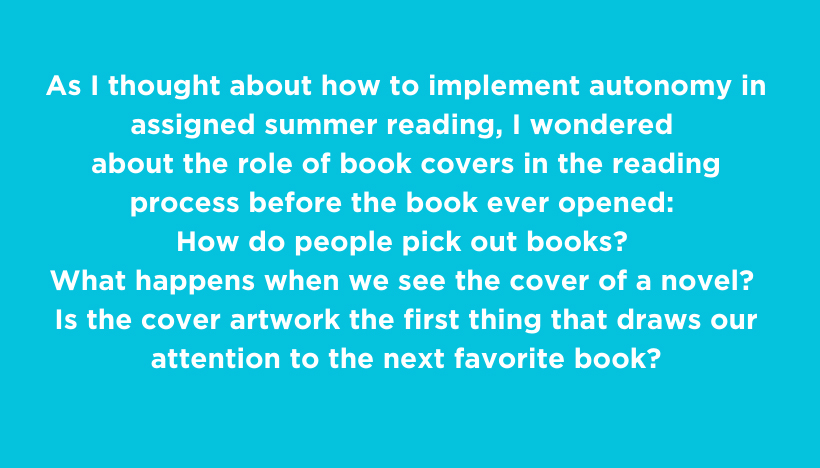This post was written by NCTE member Shelby Boehm.
These are unusual times for teachers and students.
With the summer months looming, weeks usually spent reflecting on a year of learning look different, as classrooms are mostly empty due to the COVID-19 global pandemic. Now as the newness of virtual learning becomes routine, anxiety about missed learning opportunities is growing in anticipation of a new school year.
Required summer reading is a common literacy practice in many English courses. These reading assignments are usually made at the end of one school year with a deadline during the first week of the upcoming school year. The teaching practice of summer reading has often been utilized to offset “the summer slide” (i.e., the loss of literacy development over summer months).
While the health and overall well being of future students is a top priority, you may also be thinking about how to support literacy learning over the summer in preparation for a new school year. Below, I suggest one approach to assigned summer reading that worked well in my high school English classroom.
A Picture is Worth . . . How Many Words?
During my teacher preparation program, my writing methods professor, Dr. Jane Townsend, brought a stack of postcards from various art museums to class one afternoon. She asked us each to pick a postcard. After time to consider our options, we used our chosen postcard during a free-writing activity. We then talked about the power of visual literacy, and how images might inform our future classroom instruction.
Later, as a high school teacher, I used visuals often in my lessons. After a less-than-successful iteration of assigned summer reading during my first year of teaching, I started to rethink my approach. Since my previous summer reading assignment involved assigning one text for all students to read, I knew I wanted to give students some freedom to choose their book.
I also wanted to be more flexible and sensitive to the needs of students—hopefully the assignment would motivate students to obtain the books and read them, but their investigation and what they found out about their own reading preferences would have meaning even for students who didn’t want to or weren’t able to obtain the books.
Cover Reader: A Closer Look at Book Covers
The Cover Reader assignment was born out of my interest in using visuals in the classroom while also wanting to help students learn more about their own reader identities and preferences.
As I thought about how to implement autonomy in assigned summer reading, I wondered about the role of book covers in the reading process before the book ever opened:
- How do people pick out books?
- What happens when we see the cover of a novel?
- Is the cover artwork the first thing that draws our attention to the next favorite book?
As I thought about these questions, I began to realize that if I knew what books my students were drawn to, I might also learn more about who they are as readers and people outside of my classroom. Just like the art museum postcard activity, articulating what book cover imagery stood out and why seemed like a powerful process for developing literacy skills.
In the Cover Reader assignment (See the first page of my handout), students are asked to find five book covers for books that look interesting, and which they haven’t read, using sources available to them (Amazon, Goodreads, the library, bookstores, or even the bookshelves of friends or family) and write two or three sentences about each cover describing why it appeals to them.
While my version of the Cover Reader assignment did not require students to read the books they found interesting, students did indeed read them. Many students said that once they saw compelling texts, they felt motivated to read. Additionally, students who struggled to find texts that they gravitated towards were able to voice that challenge. While I did give occasional book suggestions, I also helped students navigate their search for interesting material.
I was most excited to realize that students, who often aren’t given choice in selecting their own reading in school, learned something about their preferences and where to find books they might enjoy. The ability to curate an engaging reading list is an invaluable skillset if we consider part of our work as English teachers to promote literacy development beyond our classroom.
Consider using the Cover Reader assignment with your own students, whether for summer reading or as a supplemental resource during the year. The activity can be easily adapted. I’ve used a similar activity to ask students to preview our classroom library. Additionally, the Cover Reader can be modified to include texts outside of print-based literacies, such as podcasts or TV series. By considering books from cover to cover, we might rethink summer reading in a way that motivates and encourages all students to build their to-be-read lists.

Shelby Boehm is a current doctoral student in English education at the University of Florida and a former high school teacher. She can be reached at sboehm@ufl.edu or on Twitter @TeamBoehm.
It is the policy of NCTE in all publications, including the Literacy & NCTE blog, to provide a forum for the open discussion of ideas concerning the content and the teaching of English and the language arts. Publicity accorded to any particular point of view does not imply endorsement by the Executive Committee, the Board of Directors, the staff, or the membership at large, except in announcements of policy, where such endorsement is clearly specified.

